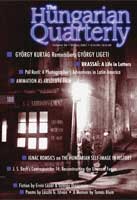From Christian Shield to EU Member
From Christian Shield to EU Member
Author(s): Ignác RomsicsSubject(s): History
Published by: Society of the Hungarian Quarterly
Summary/Abstract: The history of the Magyar people in the Carpathian Basin may be divided into four periods. The first lasted from the establishment of the medieval Hungarian state until its fall in 1526. Short periods of crisis aside, over these first five hundred years, the Kingdom of Hungary was among the most powerful and influential states in Europe. The second major period began in 1526 and lasted until the turn of the seventeenth to the eighteenth century. During this century and a half, the Kingdom of Hungary was reduced to a narrow strip of land stretching along its old northern and western borders, now associated with or subordinated to, the Habsburg family’s other Central European possessions. A large slice, lying between the extensive plains between the Danube and Tisza rivers and the mountains of Transylvania, was under the direct rule of the Turkish sultan. A new state was established in the east in the form of the Principality of Transylvania from the latter half of the sixteenth century; this paid an annual tribute as a vassal state to the Porte but, in exchange, was allowed to exercise a considerable degree of independence. The third main period may be dated from the final expulsion of the Ottoman Turks in the late seventeenth century and from the recognition of the Habsburgs’ hereditary right to the throne (for the male line in 1687, for the female line in 1723) until the dissolution of the Habsburg Empire in 1918. During this period, the Hungarian state or state bodies were, with varying degrees of autonomy, integral parts of the Habsburg Empire. The fourth period dates from after the First World War, when the Hungarian state, for the first time in close to half a millennium, once again became sovereign in terms of international law; however, its territory had shrunk to one third that of its former extent, and more than a third of ethnic Hungarians—in all some 3.3 million people—found themselves living outside the country’s new frontiers. This disposition by the Great Powers was confirmed in the aftermath of the Second World War and by the arrangements which followed the collapse of the Soviet Union in the 1990s. The aim of this article is to characterize the political thinking that attended each of these four major historical epochs; the place that the country’s political and intellectual elites envisioned for the Hungarian people among the other nations of Europe; and the distinctive role or task they saw it fulfilling.
Journal: The Hungarian Quarterly
- Issue Year: 2007
- Issue No: 188
- Page Range: 3-27
- Page Count: 25
- Language: English

